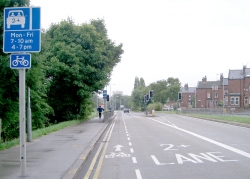| Pedestrian traffic and vehicle occupancy. 2008-07-06 |
|

Pedestrian traffic and vehicle occupancy.
2008-07-06 Pedestrians lose 8-10 times as much time as motorists gain, and are ...
Speed of traffic flow recorded automatically using ATR’s or by trained surveyors using radar guns.
2008-07-06 An automatic vehicle speed measurement system is presented that can ... |
Pedestrians lose 8-10 times as much time as motorists gain, and are exposed to greater danger; and the pedestrian losses are permanent while the motorist gains are probably transitory. Moreover, crosstown pedestrian traffic vastly outnumbers vehicular traffic — by around 6 or 7 to 1. Thus, the aggregate lengthening of pedestrian travel times exceeds the shortening of vehicular travel times by around 10 to 1. Even if the barriers improved crosstown vehicular speeds by 30%, the total time costs to pedestrians would still outweigh the time savings for motorists by almost 8 to 1. And whereas the increases in pedestrian travel times reflect physically-lengthened journeys (and associated street-crossing waiting times) and thus would be permanent, the improvements in vehicular travel times are likely to prove transitory as new vehicle trips by opportunistic drivers "use up" the reduction in vehicular congestion. Finally, the barriers force pedestrians to make new street crossings through streams of turning traffic, for a considerable increase in risk for them. An important consideration in transportation planning is the efficiency of traffic flow. Traditionally, pedestrian traffic has not been given the same priority as vehicle traffic. Reducing motor vehicle delays at traffic signals may cause increased delay to pedestrians. In heavily traveled areas with high densities of pedestrian use, motor vehicle delay must be balanced with pedestrian delay. To encourage pedestrians to continue walking rather than returning to vehicles and increasing traffic congestion, travel-time costs to both groups must be incorporated in signalization system planning. |


|
|
||||||||||||
Copyright * 2018 TRIP Consultants Corp, All Rights Reserved. |
